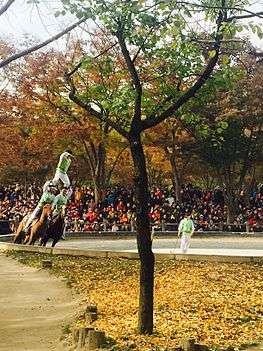Korean Folk Village
Minsok village is a living museum type of tourist attraction in the city of Yongin, a satellite city in the Seoul Metropolitan Area in the province of Gyeonggi in South Korea. It was first opened on October 3,1974 (ground breaking in 1973 and completion in 1974). Korean Folk Village is a popular tourist destination for both Koreans and foreigners. It is located near Everland, South Korea's largest amusement park.
| Korean Folk Village | |
 A performance of the farmers' dance at Korean Folk Village | |
| Korean name | |
|---|---|
| Hangul | |
| Hanja | |
| Revised Romanization | Hanguk Minsokchon |
| McCune–Reischauer | Han'guk Minsokch'on |

Real houses from across the country were relocated and restored to create a replica of a village from the late Joseon period. Events such as celebrating seasonal changes and traditional performances are held in KFV.
This village is set up in a natural environment occupying approximately 245 acres. You can see over 260 traditional houses reminiscent of the late Joseon Dynasty.
The purpose of Korean Folk Village is to display elements of traditional Korean life and culture. There are multiple sections to the park. There are numerous replicas of traditional houses of the different social classes (peasant, landowner, yangban) from various regions.
Location: #90 Minsokchon-ro, Giheung-gu, Yonginm Gyeonggi-do.
Ticket fee
| pass | Free pass | ||
|---|---|---|---|
| Adult | individual | 18,000 won | 27,000 won |
| group | 15,000 won | 21,000 won | |
| Teenager | individual | 15,000 won | 22,000 won |
| group | 13,000 won | 19,000 won | |
| Child | individual | 13,000 won | 20,000 won |
| group | 11,000 won | 17,000 won | |
Facilities
The park also has a traditional street market, restaurants, and showcases of traditional woodworking and metalworking techniques. There are performances of traditional dances, equestrian skills, marriage ceremonies, and recreational activities. There are several arts and crafts shops with food produced by local artisans as well as an ample selection of places to eat.
An amusement park section has rides and games, an art museum, a sculpture garden, a Korean Folk Museum, and a World Folk Museum which highlights traditional lifestyles from around the world.
The village was used as filming location for Munhwa Broadcasting Corporation (MBC) 2012 drama Moon Embracing the Sun as local markets, private residences of commoners, and night scenes.[1]
There are various exhibition Halls to provide sweeping view of the folk culture.
- Nine world folk exhibition hall (860 cultural artefact).
- One earth ware exhibition hall (3,000 or so cultural artefacts).
- One masked dance exhibition hall (30 cultural artefacts).
Transportation
Subway use (one transfer to bus)
- Gangnam Station: 5001-1 (10th gate, red bus, fare: 2100 won), 1560.
- Suwon Station: v10-5, v37, Korean Folk village shuttle bus (using a travel bureau at Suwon station).
- Sanggal Station: 30, 54, 10-5, 37 (Get off for Nagok Village).
- Miguem Station: 30, (shuttle bus)
Shuttle bus (there is a free shuttle bus that runs between Korean Folk Village and Suwon station).
| Location | Time | ||
|---|---|---|---|
| Suwon station → KFV | 10:30 | 12:30 | 14:30 |
| KFV → Suwon station | 13:50 | 16:00 | |
- Round trip takes about 30 minutes.

Living culture experience
Korean Folk Village is famous for the people who wear the costume of Sato (the governors), Daejanggeum (a royal cook of palace), Kumiho (legendary fox with nine tails), Geosang (business magnate in Joseon dynasty), and more interesting characters of the Joseon Dynasty.[2]
There are four typical cultural performances: Nong-ak play, tightrope play, horseback martial art play, and a traditional wedding. The performances are at each performance stage twice a day.[3] Moreover, the folk village offers cultural experience like coloring ceramics, horseback riding, and more.[4]
- Ferry
- Horseback riding
- Natural dyeing experience
- Traditional life experience
- Family park performance
- Tightrope walking performance
- KFV main performance
Traditional wedding ceremony's are also held here.
There are Jeseon Period houses and traditional work shops where it allows visitors to enjoy the architectural characteristics of Jeaseon period houses and experience traditional craft items.
- Nine ateliers
Festival
- Welcome to Joseon - Cultural theme park of Korean Folk Village hosts the “Welcome to Joseon” Variety Festival each spring. [5]An exotic program that is presented by distinctive Joseon-period characters who appear in old fairy tales or ancient stories. The mysterious and exciting cultural festival unfolds in time travel, as it is filled with performances allowing direct engagement from audience and specially prepared experience of the daily life in the Joseon period. [6]
Attraction
- Bumper cars
- Music express
- Biking
- Family Costa
- Boat ride
- Bounce spin
- Sled slope in winter
Food/Shopping
There is a market, also known as Jumak, so visitors can enjoy various Korean food. Also, it is easy to find some snack bars.
- Sweet icecream
- Winibini candy
- Railroad hotdog
- Imsil cheese pizza
There are traditional tea houses and play village restaurants.
- Herb medicine shop
- |Traditional tea house
- Railroad and Minsok Banjeom
- Eight folk village shops
- Souvenir and ateliers
Gallery

 Traditional houses
Traditional houses
 Equestrian skills displayed
Equestrian skills displayed A tightrope walker
A tightrope walker

 A farmer
A farmer Korean scarecrow
Korean scarecrow




See also
References
- "Korean TV Drama: The Moon Embracing the Sun". Korea Tourism Organization. Retrieved 2 November 2012.
- Park, Haemook (2015-10-16). "Dreams in Korean Folk Village". Korea Herald.
- Choi, Yoonhee (2015-09-09). "Various performances at Korean folk village".
- Keum, Bitna (2015-07-22). "Changes in Korean folk village among 41 years". MBN.
- Herald, The Korea (2018-05-10). "[Travel Bits] Festivals, sights around Korea". Retrieved 2018-05-13.
- "Description of Events | Korean folk village". www.koreanfolk.co.kr. Retrieved 2018-05-13.
External links
| Wikimedia Commons has media related to Korean Folk Village. |